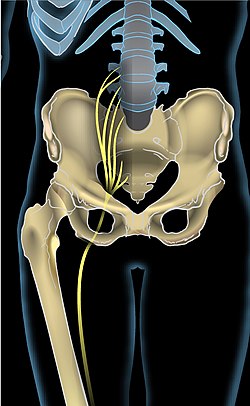Sciatic nerve
| Sciatic Nerve | |
|---|---|

Left gluteal region, showing surface markings for arteries and sciatic nerve
|
|
| Details | |
| From | Lumbar and sacral plexus (L4-S3) |
| To | Tibial and common fibular nerve |
| Innervates | Lateral rotator group (except piriformis and quadratus femoris) and the posterior compartment of thigh |
| Identifiers | |
| Latin | Nervus ischiadicus |
| TA | A14.2.07.046 |
| FMA | 19034 |
|
Anatomical terms of neuroanatomy
[]
|
|
The sciatic nerve (/saɪˈætɪk/; also called ischiadic nerve, ischiatic nerve) is a large nerve in humans and other animals. It begins in the lower back and runs through the and down the lower limb. It is the longest and widest single nerve in the human body, going from the top of the leg to the foot on the posterior aspect. The sciatic nerve provides the connection to the nervous system for nearly the whole of the skin of the leg, the muscles of the back of the thigh, and those of the leg and foot. It is derived from spinal nerves L4 to S3. It contains fibers from both the anterior and posterior divisions of the lumbosacral plexus.
The sciatic nerve is formed from the L4 to S3 segments of the sacral plexus, a collection of nerve fibres that emerge from the sacral part of the spinal cord. The fibres unite to form a single nerve in front of the piriformis muscle. The nerve passes beneath piriformis and through the greater sciatic foramen, exiting the pelvis. From here, it travels down the posterior thigh to the popliteal fossa. The nerve travels in the posterior compartment of the thigh behind (superficial to) the adductor magnus muscle, and is itself in front of (deep to) one head of the biceps femoris muscle. At the popliteal fossa, the nerve divides into its two branches:
...
Wikipedia
